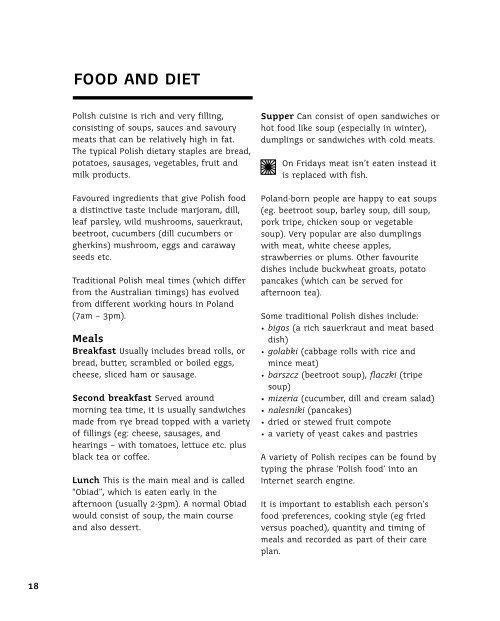Polish Culture profile - Diversicare
Polish Culture profile - Diversicare
Polish Culture profile - Diversicare
You also want an ePaper? Increase the reach of your titles
YUMPU automatically turns print PDFs into web optimized ePapers that Google loves.
18<br />
FOOD AND DIET<br />
<strong>Polish</strong> cuisine is rich and very filling,<br />
consisting of soups, sauces and savoury<br />
meats that can be relatively high in fat.<br />
The typical <strong>Polish</strong> dietary staples are bread,<br />
potatoes, sausages, vegetables, fruit and<br />
milk products.<br />
Favoured ingredients that give <strong>Polish</strong> food<br />
a distinctive taste include marjoram, dill,<br />
leaf parsley, wild mushrooms, sauerkraut,<br />
beetroot, cucumbers (dill cucumbers or<br />
gherkins) mushroom, eggs and caraway<br />
seeds etc.<br />
Traditional <strong>Polish</strong> meal times (which differ<br />
from the Australian timings) has evolved<br />
from different working hours in Poland<br />
(7am – 3pm).<br />
Meals<br />
Breakfast Usually includes bread rolls, or<br />
bread, butter, scrambled or boiled eggs,<br />
cheese, sliced ham or sausage.<br />
Second breakfast Served around<br />
morning tea time, it is usually sandwiches<br />
made from rye bread topped with a variety<br />
of fillings (eg: cheese, sausages, and<br />
hearings – with tomatoes, lettuce etc. plus<br />
black tea or coffee.<br />
Lunch This is the main meal and is called<br />
“Obiad”, which is eaten early in the<br />
afternoon (usually 2-3pm). A normal Obiad<br />
would consist of soup, the main course<br />
and also dessert.<br />
Supper Can consist of open sandwiches or<br />
hot food like soup (especially in winter),<br />
dumplings or sandwiches with cold meats.<br />
On Fridays meat isn’t eaten instead it<br />
is replaced with fish.<br />
Poland-born people are happy to eat soups<br />
(eg. beetroot soup, barley soup, dill soup,<br />
pork tripe, chicken soup or vegetable<br />
soup). Very popular are also dumplings<br />
with meat, white cheese apples,<br />
strawberries or plums. Other favourite<br />
dishes include buckwheat groats, potato<br />
pancakes (which can be served for<br />
afternoon tea).<br />
Some traditional <strong>Polish</strong> dishes include:<br />
• bigos (a rich sauerkraut and meat based<br />
dish)<br />
• golabki (cabbage rolls with rice and<br />
mince meat)<br />
• barszcz (beetroot soup), flaczki (tripe<br />
soup)<br />
• mizeria (cucumber, dill and cream salad)<br />
• nalesniki (pancakes)<br />
• dried or stewed fruit compote<br />
• a variety of yeast cakes and pastries<br />
A variety of <strong>Polish</strong> recipes can be found by<br />
typing the phrase ‘<strong>Polish</strong> food’ into an<br />
Internet search engine.<br />
It is important to establish each person’s<br />
food preferences, cooking style (eg fried<br />
versus poached), quantity and timing of<br />
meals and recorded as part of their care<br />
plan.







